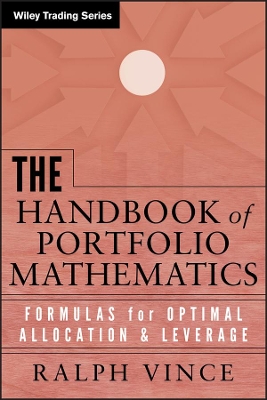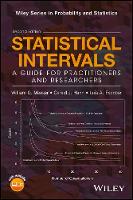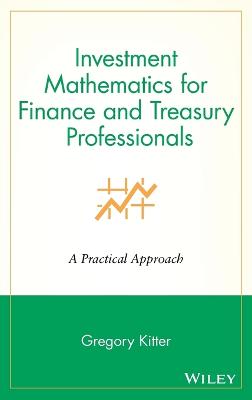Handbook of Portfolio Mathematics
 -15%
portes grátis
-15%
portes grátis
Handbook of Portfolio Mathematics
Formulas for Optimal Allocation and Leverage
Vince, Ralph
John Wiley & Sons Inc
06/2007
448
Dura
Inglês
9780471757689
15 a 20 dias
792
Introduction xvii
Part I Theory 1
Chapter 1 The Random Process and Gambling Theory 3
Independent versus Dependent Trials Processes 5
Mathematical Expectation 6
Exact Sequences, Possible Outcomes, and the Normal Distribution 8
Possible Outcomes and Standard Deviations 11
The House Advantage 15
Mathematical Expectation Less than Zero Spells Disaster 18
Baccarat 19
Numbers 20
Pari-Mutuel Betting 21
Winning and Losing Streaks in the Random Process 24
Determining Dependency 25
The Runs Test, Z Scores, and Confidence Limits 27
The Linear Correlation Coefficient 32
Chapter 2 Probability Distributions 43
The Basics of Probability Distributions 43
Descriptive Measures of Distributions 45
Moments of a Distribution 47
The Normal Distribution 52
The Central Limit Theorem 52
Working with the Normal Distribution 54
Normal Probabilities 59
Further Derivatives of the Normal 65
The Lognormal Distribution 67
The Uniform Distribution 69
The Bernoulli Distribution 71
The Binomial Distribution 72
The Geometric Distribution 78
The Hypergeometric Distribution 80
The Poisson Distribution 81
The Exponential Distribution 85
The Chi-Square Distribution 87
The Chi-Square "Test" 88
The Student's Distribution 92
The Multinomial Distribution 95
The Stable Paretian Distribution 96
Chapter 3 Reinvestment of Returns and Geometric Growth Concepts 99
To Reinvest Trading Profits or Not 99
Measuring a Good System for Reinvestment-The Geometric Mean 103
Estimating the Geometric Mean 107
How Best to Reinvest 109
Chapter 4 Optimal f 117
Optimal Fixed Fraction 117
Asymmetrical Leverage 118
Kelly 120
Finding the Optimal f by the Geometric Mean 122
To Summarize Thus Far 125
How to Figure the Geometric Mean Using Spreadsheet Logic 127
Geometric Average Trade 127
A Simpler Method for Finding the Optimal f 128
The Virtues of the Optimal f 130
Why You Must Know Your Optimal f 132
Drawdown and Largest Loss with f 141
Consequences of Straying Too Far from the Optimal f 145
Equalizing Optimal f 151
Finding Optimal f via Parabolic Interpolation 157
The Next Step 161
Scenario Planning 162
Scenario Spectrums 173
Chapter 5 Characteristics of Optimal f 175
Optimal f for Small Traders Just Starting Out 175
Threshold to Geometric 177
One Combined Bankroll versus Separate Bankrolls 180
Treat Each Play as If Infinitely Repeated 182
Efficiency Loss in Simultaneous Wagering or Portfolio Trading 185
Time Required to Reach a Specified Goal and the Trouble with Fractional f 188
Comparing Trading Systems 192
Too Much Sensitivity to the Biggest Loss 193
The Arc Sine Laws and Random Walks 194
Time Spent in a Drawdown 197
The Estimated Geometric Mean (or How the Dispersion of Outcomes Affects Geometric Growth) 198
The Fundamental Equation of Trading 202
Why Is f Optimal? 203
Chapter 6 Laws of Growth, Utility, and Finite Streams 207
Maximizing Expected Average Compound Growth 209
Utility Theory 217
The Expected Utility Theorem 218
Characteristics of Utility Preference Functions 218
Alternate Arguments to Classical Utility Theory 221
Finding Your Utility Preference Curve 222
Utility and the New Framework 226
Chapter 7 Classical Portfolio Construction 231
Modern Portfolio Theory 231
The Markowitz Model 232
Definition of the Problem 235
Solutions of Linear Systems Using Row-Equivalent Matrices 246
Interpreting the Results 252
Chapter 8 The Geometry of Mean Variance Portfolios 261
The Capital Market Lines (CMLs) 261
The Geometric Efficient Frontier 266
Unconstrained Portfolios 273
How Optimal f Fits In 277
Completing the Loop 281
Chapter 9 The Leverage Space Model 287
Why This New Framework Is Better 288
Multiple Simultaneous Plays 299
A Comparison to the Old Frameworks 302
Mathematical Optimization 303
The Objective Function 305
Mathematical Optimization versus Root Finding 312
Optimization Techniques 313
The Genetic Algorithm 317
Important Notes 321
Chapter 10 The Geometry of Leverage Space Portfolios 323
Dilution 323
Reallocation 333
Portfolio Insurance and Optimal f 335
Upside Limit on Active Equity and the Margin Constraint 341
f Shift and Constructing a Robust Portfolio 342
Tailoring a Trading Program through Reallocation 343
Gradient Trading and Continuous Dominance 345
Important Points to the Left of the Peak in the n + 1 Dimensional Landscape 351
Drawdown Management and the New Framework 359
Part II Practice 365
Chapter 11 What the Professionals Have Done 367
Commonalities 368
Differences 368
Further Characteristics of Long-Term Trend Followers 369
Chapter 12 The Leverage Space Portfolio Model in the Real World 377
Postscript 415
Index 417
Introduction xvii
Part I Theory 1
Chapter 1 The Random Process and Gambling Theory 3
Independent versus Dependent Trials Processes 5
Mathematical Expectation 6
Exact Sequences, Possible Outcomes, and the Normal Distribution 8
Possible Outcomes and Standard Deviations 11
The House Advantage 15
Mathematical Expectation Less than Zero Spells Disaster 18
Baccarat 19
Numbers 20
Pari-Mutuel Betting 21
Winning and Losing Streaks in the Random Process 24
Determining Dependency 25
The Runs Test, Z Scores, and Confidence Limits 27
The Linear Correlation Coefficient 32
Chapter 2 Probability Distributions 43
The Basics of Probability Distributions 43
Descriptive Measures of Distributions 45
Moments of a Distribution 47
The Normal Distribution 52
The Central Limit Theorem 52
Working with the Normal Distribution 54
Normal Probabilities 59
Further Derivatives of the Normal 65
The Lognormal Distribution 67
The Uniform Distribution 69
The Bernoulli Distribution 71
The Binomial Distribution 72
The Geometric Distribution 78
The Hypergeometric Distribution 80
The Poisson Distribution 81
The Exponential Distribution 85
The Chi-Square Distribution 87
The Chi-Square "Test" 88
The Student's Distribution 92
The Multinomial Distribution 95
The Stable Paretian Distribution 96
Chapter 3 Reinvestment of Returns and Geometric Growth Concepts 99
To Reinvest Trading Profits or Not 99
Measuring a Good System for Reinvestment-The Geometric Mean 103
Estimating the Geometric Mean 107
How Best to Reinvest 109
Chapter 4 Optimal f 117
Optimal Fixed Fraction 117
Asymmetrical Leverage 118
Kelly 120
Finding the Optimal f by the Geometric Mean 122
To Summarize Thus Far 125
How to Figure the Geometric Mean Using Spreadsheet Logic 127
Geometric Average Trade 127
A Simpler Method for Finding the Optimal f 128
The Virtues of the Optimal f 130
Why You Must Know Your Optimal f 132
Drawdown and Largest Loss with f 141
Consequences of Straying Too Far from the Optimal f 145
Equalizing Optimal f 151
Finding Optimal f via Parabolic Interpolation 157
The Next Step 161
Scenario Planning 162
Scenario Spectrums 173
Chapter 5 Characteristics of Optimal f 175
Optimal f for Small Traders Just Starting Out 175
Threshold to Geometric 177
One Combined Bankroll versus Separate Bankrolls 180
Treat Each Play as If Infinitely Repeated 182
Efficiency Loss in Simultaneous Wagering or Portfolio Trading 185
Time Required to Reach a Specified Goal and the Trouble with Fractional f 188
Comparing Trading Systems 192
Too Much Sensitivity to the Biggest Loss 193
The Arc Sine Laws and Random Walks 194
Time Spent in a Drawdown 197
The Estimated Geometric Mean (or How the Dispersion of Outcomes Affects Geometric Growth) 198
The Fundamental Equation of Trading 202
Why Is f Optimal? 203
Chapter 6 Laws of Growth, Utility, and Finite Streams 207
Maximizing Expected Average Compound Growth 209
Utility Theory 217
The Expected Utility Theorem 218
Characteristics of Utility Preference Functions 218
Alternate Arguments to Classical Utility Theory 221
Finding Your Utility Preference Curve 222
Utility and the New Framework 226
Chapter 7 Classical Portfolio Construction 231
Modern Portfolio Theory 231
The Markowitz Model 232
Definition of the Problem 235
Solutions of Linear Systems Using Row-Equivalent Matrices 246
Interpreting the Results 252
Chapter 8 The Geometry of Mean Variance Portfolios 261
The Capital Market Lines (CMLs) 261
The Geometric Efficient Frontier 266
Unconstrained Portfolios 273
How Optimal f Fits In 277
Completing the Loop 281
Chapter 9 The Leverage Space Model 287
Why This New Framework Is Better 288
Multiple Simultaneous Plays 299
A Comparison to the Old Frameworks 302
Mathematical Optimization 303
The Objective Function 305
Mathematical Optimization versus Root Finding 312
Optimization Techniques 313
The Genetic Algorithm 317
Important Notes 321
Chapter 10 The Geometry of Leverage Space Portfolios 323
Dilution 323
Reallocation 333
Portfolio Insurance and Optimal f 335
Upside Limit on Active Equity and the Margin Constraint 341
f Shift and Constructing a Robust Portfolio 342
Tailoring a Trading Program through Reallocation 343
Gradient Trading and Continuous Dominance 345
Important Points to the Left of the Peak in the n + 1 Dimensional Landscape 351
Drawdown Management and the New Framework 359
Part II Practice 365
Chapter 11 What the Professionals Have Done 367
Commonalities 368
Differences 368
Further Characteristics of Long-Term Trend Followers 369
Chapter 12 The Leverage Space Portfolio Model in the Real World 377
Postscript 415
Index 417












